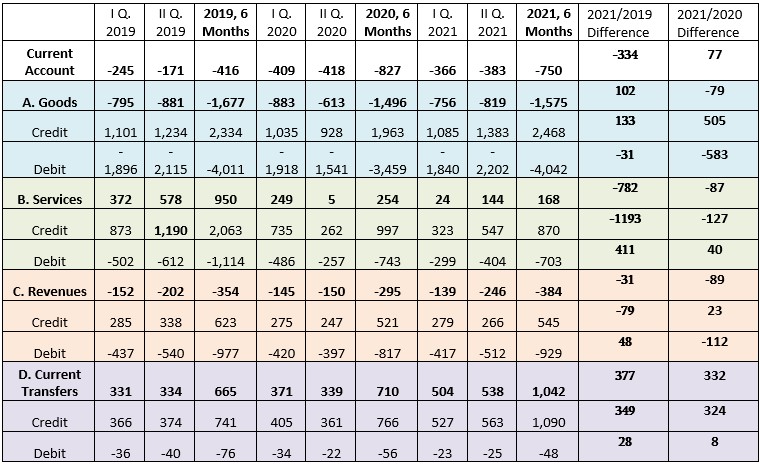A current account is a constituent part of the balance of payments. The latter is a statistical account which includes economic relations and transactions made between a specific country and the rest of the world. A current account includes goods and service, primary incomes [1] and current transfers (secondary incomes [2]). Therefore, a current account deficit shows the difference between a country’s trade balance and incomes.
The bulk of a current account deficit is precisely the trade balance which shows whether a country’s output is more or less as compared to a country’s consumption. In the case of Georgia, less goods and services are produced than consumed. Therefore, we have a negative trade balance which means that imports of goods and services exceed exports. In this case, there is a current account deficit which is mostly affected by the export-import figures. In turn, sources to offset the deficit are capital transfers, foreign investments and external debt. This is reflected in capital and financial accounts. The current account dynamic in 2012-2020 is shown in Graph 1. Since 2016, the current account deficit to the GDP ratio has been declining annually, although the current account deficit reached USD 1.962 billion by 2020 which was 105% growth as compared to the previous year. In 2020, the current account deficit was linked with shrinking exports which in turn was stipulated by the suspension of the tourism industry because of the pandemic crisis. In particular, revenues from travel were USD 361 million in 2020 whilst Georgia received USD 2.6 billion in revenues from travel in 2019.
Graph 1: Current Account Deficit in 2012-2020, USD Million

Source: National Bank of Georgia
In the first half of 2021, the current account deficit was USD 749.7 million which is a 10% decline as compared to the same period of the previous year and an 80% growth as compared to the first six months of 2019. In the second quarter of 2021, the current account deficit reached USD 383 million which is a 9% decline as compared to the same period of the previous year. Of note is that according to the data of the first half of 2021, incomes from travel amounted to USD 242.7 million which is a 24% decrease as compared to the same period of 2020. However, the pandemic-related restrictions were not imposed in full in the first quarter of 2020 which stipulated a positive economic dynamic in that period. This complicates the analysis of the pandemic context. In the second quarter of 2021, incomes from travel increased by 750% as compared to the second quarter of 2020 whilst they decreased by 72% as compared to the second quarter of 2019.
According to the data of the first six months of 2021, the reduction of the current account deficit was caused by the growth of transfers (secondary incomes) by 47% from USD 710 million to USD 1 billion. However, according to the data of January-June 2021, the deficit widened in the trade in goods and services and primary incomes. In the second quarter of 2021, revenues from trade in goods decreased by USD 206 million and from primary incomes by USD 96 million whilst incomes from services increased by USD 138 million and incomes from transfers by USD 202 million as compared to the second quarter of 2020.
Table 1: Current Account Statistics in the First Halves of 2019, 2020 and 2021, USD Million

Source: National Bank of Georgia
[1] This shows flows of primary income between resident and non-resident institutional units. It includes labour remuneration and investment income.
[2] Secondary incomes account shows current transfers between the country’s residents and non-residents.







